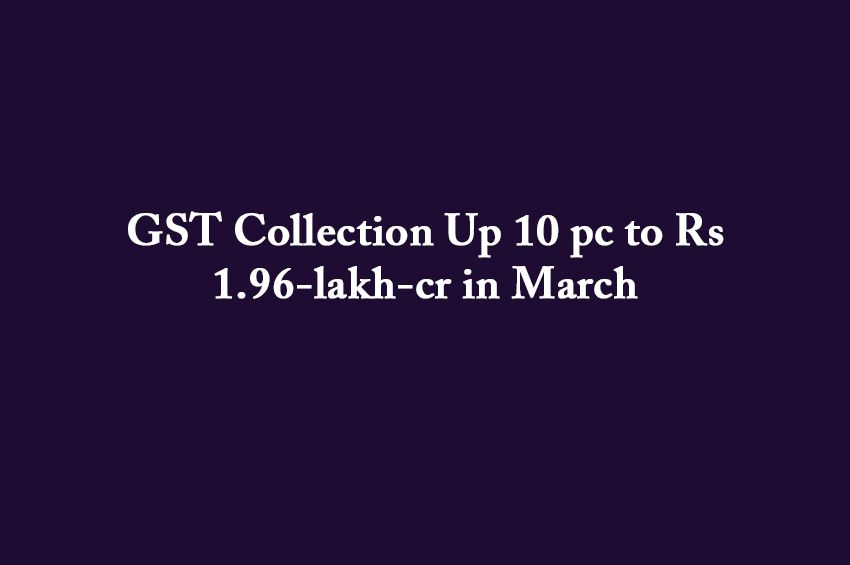Winning Bizness Economic Desk
The revenue collection from the Goods and Services Tax (GST) moved northward by ten per cent Year-on-Year (YoY) to Rs 1.96-lakh-crore in March, propelled by a very heathy mop-up in states such as Maharashtra, Haryana and Uttar Pradesh.
Karnataka, however, registered a slow growth, data from the Union Finance Ministry showed.
After adjusting refunds, net GST revenue during the month stood at Rs 1.76-lakh-crore, which is 7.3 per cent higher when compared with the same month last year.
An important point to note here is that in the southern state of Karnataka, the GST collection stood at Rs 13,947-crore in March, posting a low growth of only four per cent over the same month last year.
Interestingly, Karnataka is the second-largest contributor to the country’s indirect tax kitty.
The western coastal state of Maharashtra is the biggest contributor to the GST kitty—the state registered a very healthy growth in double-digits of 14 per cent at Rs 31,534-crore as against the Rs 27,688-crore clocked in the same year-ago month.
The GST revenue from domestic transactions rose by 8.8 per cent to Rs 1.49-lakh-crore, while revenue from imported goods climbed up by 13.56 per cent to Rs 46,919-crore.
The full year GST revenue collection in 2024-25 stood at Rs 22.08-lakh-crore which is 9.4 per cent higher when compared to the Rs 20.18-lakh-crore collection clocked in 2023-24.
There was a sharp increase in refunds during the month and GST refunds to exporters climbed up by 202 per cent.
India’s Growth to be Highest Among Advanced, Emerging G20 Nations: Moody’s
Moody’s Ratings has said that the country’s growth at 6.5 per cent this fiscal will remain the highest amongst the advanced and emerging G20 nations.
This growth will be driven by tax measures and continued monetary easing, and the country will continue to attract capital and withstand any cross-border outflow.
In its report on emerging markets, Moody’s said that such economies are “exposed to choppy waters” from the churn of US policies and its potential to reshape global capital flows, supply-chains, trade and geo-politics.
It said that economic activity in the fastest-growing economies will slow slightly from high levels but remain strong this year and the next.
For China, exports and investments in infrastructure and priority high-tech sectors remain the main growth drivers, while domestic consumption remains weak.
“India’s growth will remain the highest of the advanced and emerging G20 countries, supported by tax measures and continued (monetary) easing,” Moody’s said, while projecting a 6.5 per cent growth for 2025-26 fiscal, down from 6.7 per cent in 2024-25.
Skoda Registers Best-Ever Monthly Sales in March
Automobile major Skoda Auto India has marked a significant milestone in its 25-year journey by clocking its highest-ever monthly sales in March of this year.
The company sold 7,422 units, driven by a strong demand for the newly-launched compact SUV, the Kylaq.
Here, it must be pointed out that this achievement follows the introduction of the Kylaq and the appointment of film actor Ranveer Singh as its first-ever brand superstar.
Launched in January of this year, the Kylaq has played a key role in the sales surge witnessed by the company. It is Skoda’s first sub-4m SUV, offering five-star safety.
The car received over 15,000 bookings, prompting Skoda to ramp-up production to fulfil all orders by May 2025.
Skoda Auto India has expanded its network from 120 touchpoints in 2021 to over 280, with plans to reach 350 by end-2025.
A point that requires highlighting here is that the company has also introduced digital showrooms, on-line-only sales and a one-year complementary maintenance package to enhance customer experience.
Skoda Auto India’s Brand Director, Mr Petr Janeba, said that “the 7,422 cars we sold in March 2025 reflect our commitment to bringing European technologies to Indian roads.”
“The Kylaq’s success highlights the demand for comfort, space and safety in the sub-4m SUV segment. To celebrate this success, we are extending the introductory pricing until the end of April.”
Dhruv Agarwala Resigns as CEO of REA India
Mr Dhruv Agarwala, the CEO of REA India that owns real estate classified platform Housing.com has resigned from the company in order to pursue his own entrepreneurial journey.
In 2011, Mr Agarwala co-founded property tech firm Elara Technologies which owned PropTiger, one of the leading housing brokerage firms in the country.
Later, in 2017, he acquired Housing.com from Softbank and others. Australia’s REA group acquired Elara Technologies in 2020 and took control of Housing.com and PropTiger.
In a statement, Australia’s REA group announced that Mr Agarwala has decided to step down as CEO of REA India after fourteen years with the business.
“Agarwala will remain with the business to support the appointment of his successor and ensure a smooth leadership transition before departing. A comprehensive process to appoint a new CEO is underway,” it added.
The REA group’s CEO Mr Owen Wilson said that Mr Agarwala’s leadership had been a key driver of REA India’s growth.
“Dhruv is an exceptional entrepreneur and has harnessed the rapid expansion of digital real estate in India to build a high growth business…He leaves behind a considerable legacy that will have a lasting impact,” Mr Wilson added.
Mr Agarwala said that it had been a privilege leading REA India.
REA India posed a 46 per cent growth in its revenue to Australian dollar 64-million (Rs 357-crore) in the first-half of 2024-25 fiscal year ending June, helping it to reduce losses.
The company’s revenue expanded 31 per cent to Rs 563-crore in 2023-24 fiscal (July-to-June) from Rs 430-crore in the preceding year.
REA India, which is a part of Australia’s publicly-listed firm REA, is a full-stack real estate technology firm and owns two on-line classified advertising platforms Housing.com and Makaan.com as well as housing brokerage platform PropTiger.
Housing Sales Slide 28 pc in Top 7 Cities, Prices Increase, Says Report
Housing sales in the first-quarter of 2025 (Q1 2025) in India’s top seven cities slid southward by a big 28 per cent from the year before. Rising prices and geo-political headwinds pulled the segment down, a report said.
93,280 units were sold in Q1 2025 (January-to-March) and 1,30,170 units in the same period a year-ago, according to Anarock.
The real estate agency touched housing sales in the Mumbai Metropolitan Region (MMR), Bangalore, Pune, the National Capital Region (NCR), Hyderabad, Chennai and Kolkata.
The average residential property price in the seven cities increased ten per cent to 34 per cent in Q1 2025 due to new supplies in the luxury and ultra-luxury segments and overall demand, the report said.
NCR and Bangalore recorded the highest annual price jumps of more than 34 per cent and 20 per cent.
“MMR and Pune accounted for 51 per cent of the total sales, with MMR seeing a 26 per cent yearly drop and Pune, a decline of over 30 per cent. At 49 per cent, Hyderabad saw the highest annual drop in sales, while Bangalore had the lowest decline at 16 per cent,” said Mr Anuj Puri, Chairman, Anarock Group.
New launches across the seven cities were above the one-lakh mark but saw a ten per cent yearly decline—from approximately 1,10,865 units in Q1 2024 to about 1,00,020 units in Q1 2025.
“Notably, MMR and Bangalore saw maximum new supply in Q1 2025, accounting for 52 per cent of the total new launches across the top seven cities,” Mr Puri said.
New housing supply grew 53 per cent, 27 per cent and 26 per cent in NCR, Bangalore and Kolkata, respectively. It declined 55 per cent in Hyderabad, the most among the seven cities and nine per cent in MMR


